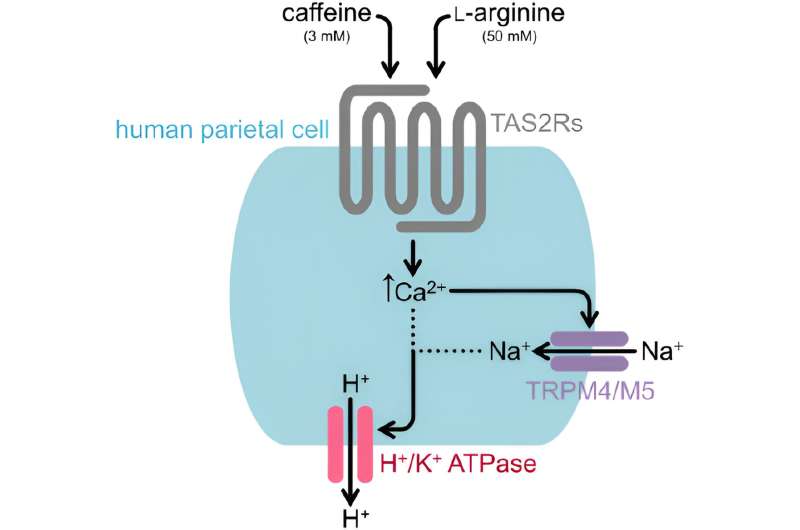This article has been reviewed according to Science X's editorial process and policies. Editors have highlighted the following attributes while ensuring the content's credibility:
fact-checked
peer-reviewed publication
trusted source
proofread
Bitter substances make the stomach acidic: How bitter food constituents influence gastric acid production

In the stomach, parietal cells are responsible for acid production. They react not only to the body's own messenger molecules, but also to bitter-tasting food constituents such as caffeine.
A research team from the Leibniz Institute for Food Systems Biology at the Technical University of Munich has now carried out a study on a human gastric cell line. Their results help to clarify the molecular regulatory mechanisms by which bitter substances influence gastric acid production.
The findings are published in the Journal of Agricultural and Food Chemistry.
It is known that taste receptors for bitter substances are not only found on the tongue, but also on the surface of other tissues and cells. These include the parietal cells of the stomach, which secrete protons into the stomach—i.e., produce gastric acid.
Recent studies have already shown that the bitter taste receptors found in parietal cells are involved in the regulation of gastric acid release. However, the underlying molecular signaling pathways are not yet fully understood.
Gastric cells as a test system
To further clarify the molecular interaction between bitter substances, bitter taste receptors, and gastric acid production, a research team led by Veronika Somoza, Director of the Leibniz Institute in Freising, has carried out a study on a cellular test system. This involves human parietal HGT-1 cells, which are able to secrete protons and, like taste cells, have bitter taste receptors.
Veronika Somoza's team initially developed a working hypothesis based on the results of previous studies and the findings on signal transduction pathways in taste cells.
According to this hypothesis, bitter tasting food constituents stimulate bitter taste receptors that are embedded in the cell membrane. This releases calcium ions inside the cells, leading to ion channel opening. This, in turn, allows sodium ions to flow into the gastric cells from the outside, ultimately contributing to the release of protons.
Hypothesis confirmed
First author Phil Richter explains, "We have successfully tested this mechanism with the two bitter substances caffeine and l-arginine. As expected from previous results, both food constituents were shown to stimulate gastric cell proton secretion in our test system."
The Ph.D. student adds, "For the first time, we were able to demonstrate that the transient receptor potential channels M4 and M5 are involved in the signaling cascade not only in taste cells but also in gastric cells and ensure an influx of sodium ions into the cells."
Senior Scientist Gaby Andersen says, "By using knock-out experiments, in which we specifically switched off one type of bitter taste receptor in the cells, we were also able to show for the first time that there is a link between bitter taste receptors and the activation of the ion channels."
The scientist emphasizes that the results not only contribute to a better understanding of the role of taste receptors in the stomach but could also show that HGT-1 cells could be suitable as a replacement model for taste cells.
The research team agrees that the results will provide new insights into the regulation of gastric acid production and thus lead to innovative approaches in treating gastric diseases in the long term. However, further studies are needed to deepen knowledge of the molecular regulatory mechanisms and intracellular signaling pathways.
More information: Phil Richter et al, Sodium-Permeable Ion Channels TRPM4 and TRPM5 are Functional in Human Gastric Parietal Cells in Culture and Modulate the Cellular Response to Bitter-Tasting Food Constituents, Journal of Agricultural and Food Chemistry (2024). DOI: 10.1021/acs.jafc.3c09085



















